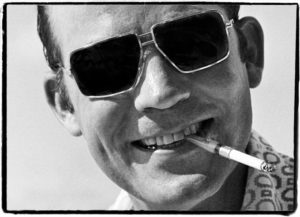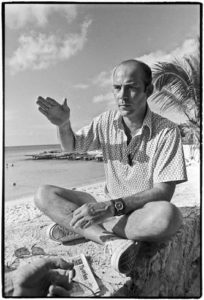Hunting Thompson
An interview with Joe Barclay, March 25, 2015
This interview was conducted for Boats Against the Current, Barclay’s magazine that grew from a school project at Kingston University in England.

Barclay told me his project was “focusing on the difference between the perceived image of Hunter Thompson as a mad, drink- and drug-addled outlaw in Fear and Loathing in Las Vegas in contrast with the human side that is shown through his letters in The Proud Highway and Fear and Loathing in America.”
In the interview below, Barclay’s questions are in boldface and my responses are in regular type.
……….
What was your first encounter with Hunter Thompson like?
I was to introduce him to a university audience and interview him onstage. This was 1978. I expected the mad-dog caricature so I was surprised by his friendly and courteous manner.
We sat backstage and chatted a bit and he asked about my family (I didn’t realize his family life was in turmoil at the time) and he seemed like a guy you’d strike up a chat with at a bar.
Speaking of which, we were at Western Kentucky University in Bowling Green, and he was not allowed to drink onstage. He pulled an open Lowenbrau from his duffel, where it was wedged tightly between his clothes, and drained it in one gulp, then tossed the bottle across the room into a garbage can. I was deeply impressed.
When we went on the auditorium stage, he became the “Hunter character.” He changed the way he walked and talked.
What drew you to Hunter?

I responded to his writing immediately. I was a newspaper reporter and all of us were blown away by the serialized “Fear and Loathing in Las Vegas” that appeared in two issues of Rolling Stone in Fall 1971.
Of course, that carried a “Raoul Duke” byline (with an interior reference to “Dr. Thompson”). We finally began to figure it all out when he started covering the 1972 campaign for Rolling Stone. We’d stand by the mailbox, waiting for the next issue to be delivered. I covered that campaign as well, so it was fun to feel connected to a larger story. Too bad people don’t care about politics anymore.
There are similarites to be drawn between HST and Hemingway, not only in the way in which they committed suicide but also in the image they created of themselves.
I think Hunter was a great fan of the “heavies” – Hemingway, Fitzgerald, Faulkner, etc. He also had great admiration for Henry Miller and many others.
He was extremely well-read and entirely self-educated. As you know, he spent a lot of his young life retyping books by these writers so he’d know what their creative electricity felt like passing through his body. I think you can see a lot of Hemingway influence in the cadence of some of his writing that appeared in The National Observer.
You also see it in his columns for The San Francisco Examiner. On more than one occasion, he ended stories with variations on Hemingway’s ending from A Farewell to Arms. I think he also responded to the Hemingway image and wanted to be something of a literary he-man himself.
How much do you think HST was influenced by Hemingway?
A great deal.
Do you think that Hollywood is somewhat responsible for enhancing the myth image of Hunter?
I think he eventually became a prisoner of his persona, but it started before Where the Buffalo Roam. He created this character (Raoul Duke or, as Douglas Brinkley calls it, The Hunter Figure) who was a foaming-at-the-mouth mad-dog. It was an enhanced version of himself. It was like a Hollywood movie monster — Huntzilla, maybe — and so the character was his creation.
The caricature began to evolve with Doonesbury and then with the film portrayal. I think Bill Murray’s portrayal of Hunter was brilliant, by the way. It was unfortunately trapped inside a mediocre film.
What is your favourite piece of Hunter’s writing if you can pick one?
I can’t really pick one. I like the obvious ones, of course — the first three books — but I’m awfully fond of “He Was a Crook,” his obituary for Richard Nixon. Love to read that one to my class. I love his books of letters — both masterpieces.
Do you think that the image of Hunter that is percieved became a hinderence to him in later life?
Yes. The public wanted the character and I think he felt trapped and couldn’t explore other aspects of his massive talent. I think he used to feel that if his “public” would accept his hastily written first drafts, then why even try to rewrite or polish an article. I think he once said that Fear and Loathing in Las Vegas was the last thing he ever rewrote. That’s telling.
In his collected letters, the reader is shown a different side of HST, do you think that through these letters provide the reader with a better understanding of the man?
Yes, the letters are brilliant. Some of his best writing, if you ask me. (And I suppose you did.) I particularly like the letter he wrote to the kid who read Hell’s Angels and wrote Hunter, telling him he wanted to run away and join the gang. Hunter’s advice is touching and wise. I also love his correspondence with Tom Wolfe — some of the funniest stuff I’ve ever read in my life.
Are you aware of the reasons that The Mutineer: Rants, Ravings, and Missives from the Mountaintop 1977–2005, the third book of collected letters, remains unpublished? I have heard some reasons but it remains unclear.
I have no inside knowledge, but I suspect that since Hunter was a self-described “lazy hillbilly,” he got into the habit of faxing short handwritten notes that the production of long and thoughtful letters dropped off. They may have trouble assembling enough to make a suitable third volume. But that’s really just a guess on my part.
This year is the tenth anniversary of Hunter’s suicide, in another ten or twenty years, how do you think he will be remembered?
I think his reputation will grow. It’s amazing to me that college students today — maybe 8 years old when he took himself out — come to school in love with his work and, to some extent, with that pop-culture caricature. As journalism marches lemming-like to the cliffs of blandness, a great original voice like Hunter’s (or Tom Wolfe’s, for that matter) reminds us of what journalism can be.
